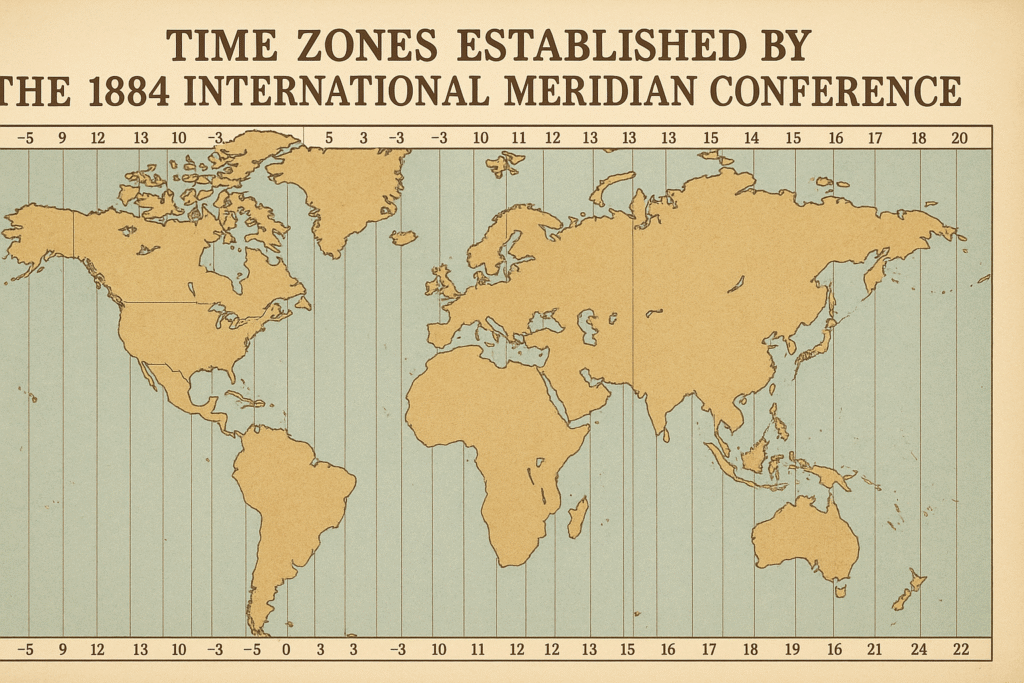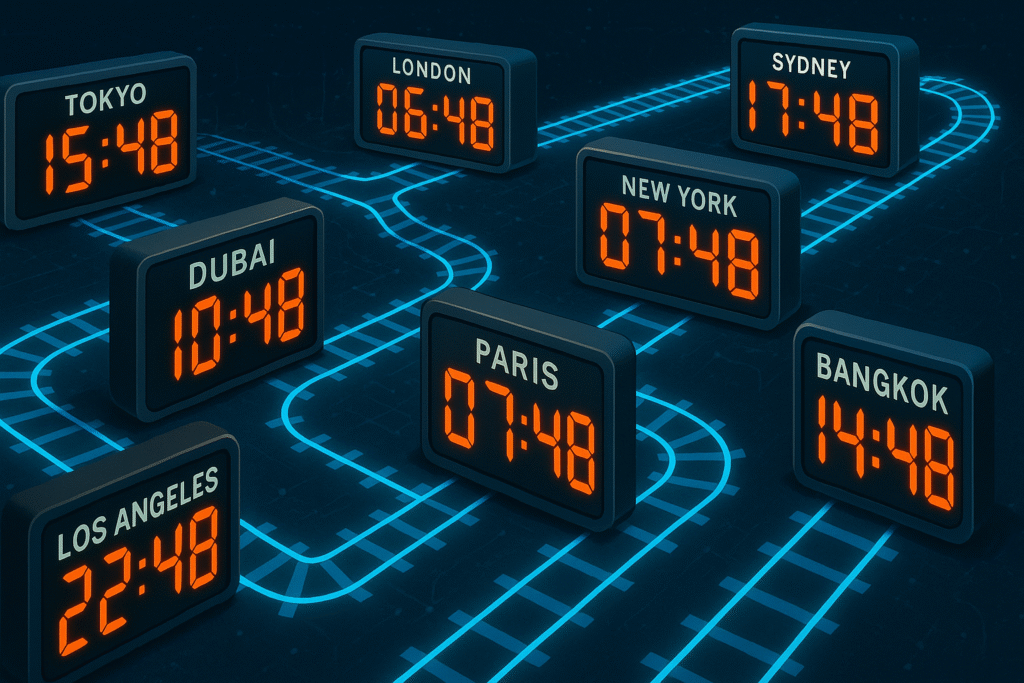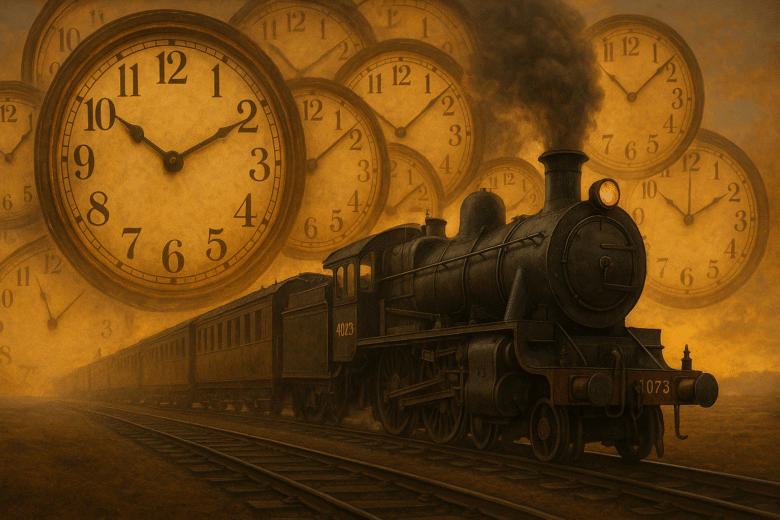Fun Fact: Before the invention of time zones, every town ran on its own local time—meaning noon in Mumbai could be different from noon in Pune.
Imagine missing your train not because you were late, but because your clock disagreed with the station master’s. That was daily reality in the 19th century, when time was a local affair. Every village and city followed the sun and kept its own “solar” time. But as the iron wheels of progress roared across continents, trains began to run into a strange problem—not speed, but time itself.
This is the story of how trains, schedules, and chaos gave birth to one of the most synchronized ideas in human history: the invention of time zones.
Time Used to Be a Mess
Before the 1800s, there was no such thing as “standard time.” People set their clocks by the position of the sun. Noon was when the sun stood directly overhead, and every city followed its own version of that moment.
This worked fine when people travelled by foot, cart, or horse. But everything changed when the railways arrived. Suddenly, you could travel 50 kilometres in an hour, crossing multiple local time zones—without leaving your country. Trains needed accurate, consistent schedules. Conductors, passengers, and stationmasters needed to agree on what time it actually was. But how could they, when each city told a different story?
In India, for instance, Bombay Time, Calcutta Time, and Madras Time all coexisted in the late 19th century. Just imagine coordinating a train from Chennai to Mumbai across three time zones.

Railways vs. Time: A Scheduling Nightmare
Let’s rewind to 19th-century Britain. The country had just witnessed a railway boom. But there was a snag—London ran on Greenwich Mean Time (GMT), while towns like Bristol were ten minutes behind.
The Great Western Railway (now part of Great Western Railway Ltd., a British train operating company) began using GMT across its stations in 1840 to avoid confusion. By the 1850s, most British railway companies had followed suit. But the public resisted. Church clocks and personal watches still stuck to local time. Some stations even displayed two clocks—one for “railway time” and another for “local time.”
In the United States, things were worse. By 1883, over 300 different local time zones were in use. Train wrecks caused by timing miscommunication were not uncommon.
The Moment of Synchronization
On November 18, 1883, American and Canadian railroads did something radical—they implemented Standard Railway Time, dividing the continent into four uniform time zones. The public called it the “Day of Two Noons” because towns suddenly shifted their clocks.
It wasn’t a government decree. It was the railway companies who took charge and forced the world to get in sync.
The international community followed suit. In 1884, delegates from 25 countries met at the International Meridian Conference in Washington, D.C. There, Greenwich, England, was chosen as the Prime Meridian (0° longitude), and the world was divided into 24 time zones, each spanning 15 degrees of longitude.
It was one of humanity’s boldest collective agreements—and it all started with trains running late.
India’s Own Time Drama
India, under British rule, adopted a standard time in 1906 called Indian Standard Time (IST)—set at 5 hours and 30 minutes ahead of GMT. But even after this, Bombay Time and Calcutta Time continued for decades. Bombay resisted IST until as late as 1955.
Even today, India operates under a single time zone despite its vast east-west spread. This means places like Arunachal Pradesh experience sunrise almost two hours earlier than Gujarat. Some experts argue that India needs at least two time zones to balance productivity, energy use, and biological rhythms.
But the idea of national unity, simplicity, and administration has kept IST untouched.
Time Became a Tool of Empire
The adoption of time zones wasn’t just about convenience—it was about control.
Colonial powers used synchronized time to manage territories, organize labour, and maintain military schedules. In Africa, Asia, and Latin America, the imposition of “railway time” also meant the imposition of colonial authority.
Time became standardized, but also centralized—decided by those in power, often far from the people whose lives it shaped.
In this sense, time zones are not just scientific—they’re political.

From Railways to the Internet: Time’s Next Frontier
Today, time zones feel obvious. Our phones update automatically, flights arrive “on time,” and international Zoom calls run like clockwork. But the legacy of synchronized time is still evolving.
- Global Positioning System (GPS), operated by the United States government, uses atomic clocks aboard satellites to keep everything from smartphones to missile systems accurate.
- Companies like Microsoft Corporation (a U.S.-based software and tech company) and Apple Inc. (an American technology giant) build time zone databases into their operating systems to support global workforces.
We now live in a world where timekeeping is invisible, yet absolutely essential.
But even this system isn’t flawless. Daylight Saving Time (DST), adopted in parts of the world, remains controversial. Some countries have abandoned it altogether. Others debate whether it causes more harm than good. And in an always-online world, some argue for a universal time system—where it’s the same time everywhere, and only your schedule shifts.
Conclusion: Living by the Clock
So, what does the story of time zones tell us?
It tells us that time is not just a number on your phone screen—it’s a construct shaped by technology, commerce, colonialism, and culture. It tells us that we didn’t all agree on “now” until the trains made us.
And it reminds us that synchronization, while efficient, can also erase the local, the personal, and the natural rhythms of life.
So, the next time your alarm rings for a morning meeting with someone across the world, think of it as a whisper from a train whistle long gone. A reminder that once upon a time, time itself had to be invented just to keep us from crashing into each other—literally.
Author’s Note
Writing this reminded me that even something as mechanical as a train schedule is soaked in history. The invention of time zones isn’t just about keeping track—it’s about how we decided, as a planet, to agree on something invisible. And that agreement still rules our lives today.
G.C., Ecosociosphere contributor.




